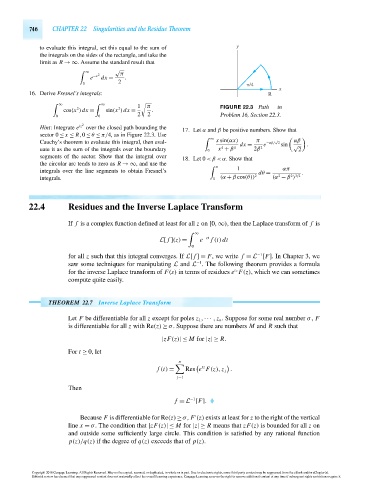Page 766 - Advanced_Engineering_Mathematics o'neil
P. 766
746 CHAPTER 22 Singularities and the Residue Theorem
to evaluate this integral, set this equal to the sum of y
the integrals on the sides of the rectangle, and take the
limit as R →∞. Assume the standard result that
√
∞ −x 2 π
e dx = .
0 2 π/4
x
16. Derive Fresnel’s integrals: R
∞ ∞ 1 π FIGURE 22.3 Path in
2 2
cos(x )dx = sin(x )dx = .
0 0 2 2 Problem 16, Section 22.3.
Hint:Integrate e iz 2 over the closed path bounding the
17. Let α and β be positive numbers. Show that
sector 0 ≤ x ≤ R,0 ≤ θ ≤ π/4, as in Figure 22.3. Use
∞
√
Cauchy’s theorem to evaluate this integral, then eval- x sin(αx) π −αβ/ 2 αβ
dx = e sin √ .
4
uate it as the sum of the integrals over the boundary 0 x + β 4 2β 2 2
segments of the sector. Show that the integral over
18. Let 0 <β <α. Show that
the circular arc tends to zero as R →∞, and use the
π
integrals over the line segments to obtain Fresnel’s 1 dθ = απ .
2 3/2
2
integrals. 0 (α + β cos(θ)) 2 (α − β )
22.4 Residues and the Inverse Laplace Transform
If f is a complex function defined at least for all z on [0,∞), then the Laplace transform of f is
∞
L[ f ](z) = e −zt f (t)dt
0
−1
for all z such that this integral converges. If L[ f ]= F, we write f = L [F]. In Chapter 3, we
−1
saw some techniques for manipulating L and L . The following theorem provides a formula
tz
for the inverse Laplace transform of F(s) in terms of residues e F(z), which we can sometimes
compute quite easily.
THEOREM 22.7 Inverse Laplace Transform
Let F be differentiable for all z except for poles z 1 ,··· , z n . Suppose for some real number σ, F
is differentiable for all z with Re(z) ≥ σ. Suppose there are numbers M and R such that
|zF(z)|≤ M for |z|≥ R.
For t ≥ 0, let
n
tz
f (t) = Res e F(z), z j .
j=1
Then
f = L [F].
−1
Because F is differentiable for Re(z)≥σ, F (z) exists at least for z to the right of the vertical
line x = σ. The condition that |zF(z)|≤ M for |z|≥ R means that zF(z) is bounded for all z on
and outside some sufficiently large circle. This condition is satisfied by any rational function
p(z)/q(z) if the degree of q(z) exceeds that of p(z).
Copyright 2010 Cengage Learning. All Rights Reserved. May not be copied, scanned, or duplicated, in whole or in part. Due to electronic rights, some third party content may be suppressed from the eBook and/or eChapter(s).
Editorial review has deemed that any suppressed content does not materially affect the overall learning experience. Cengage Learning reserves the right to remove additional content at any time if subsequent rights restrictions require it.
October 14, 2010 15:37 THM/NEIL Page-746 27410_22_ch22_p729-750

